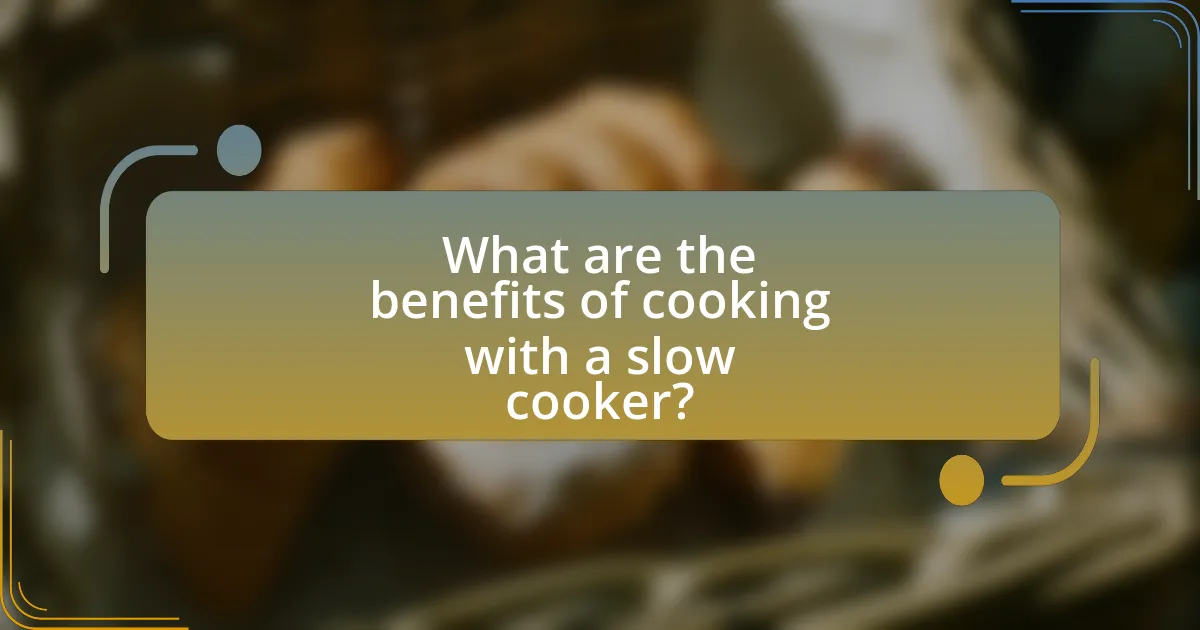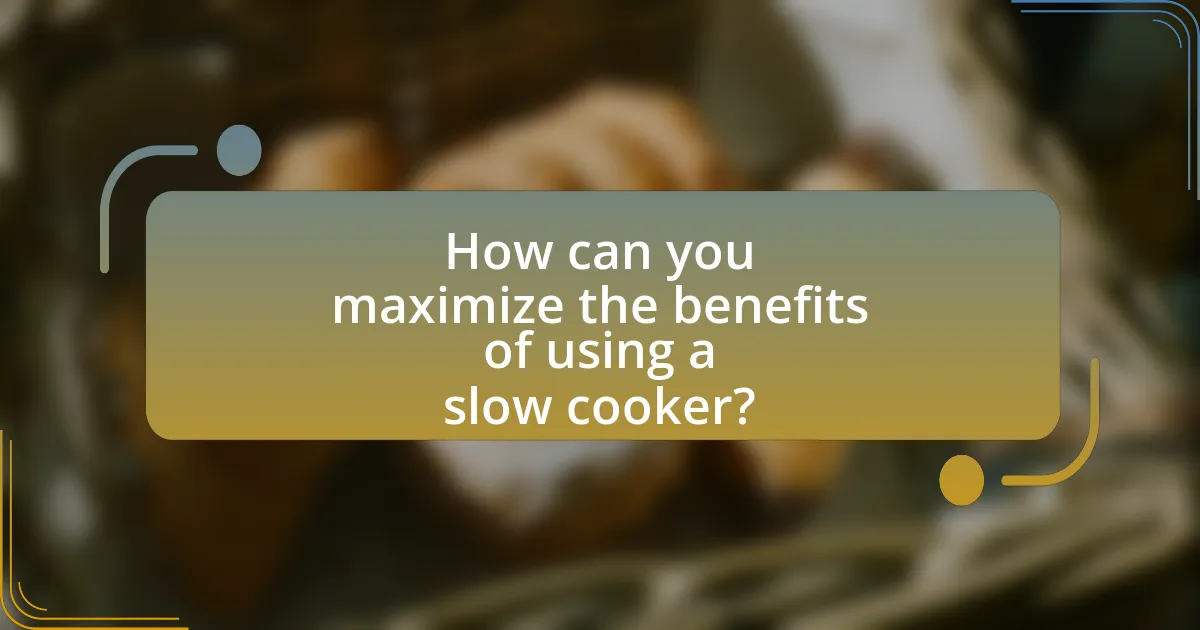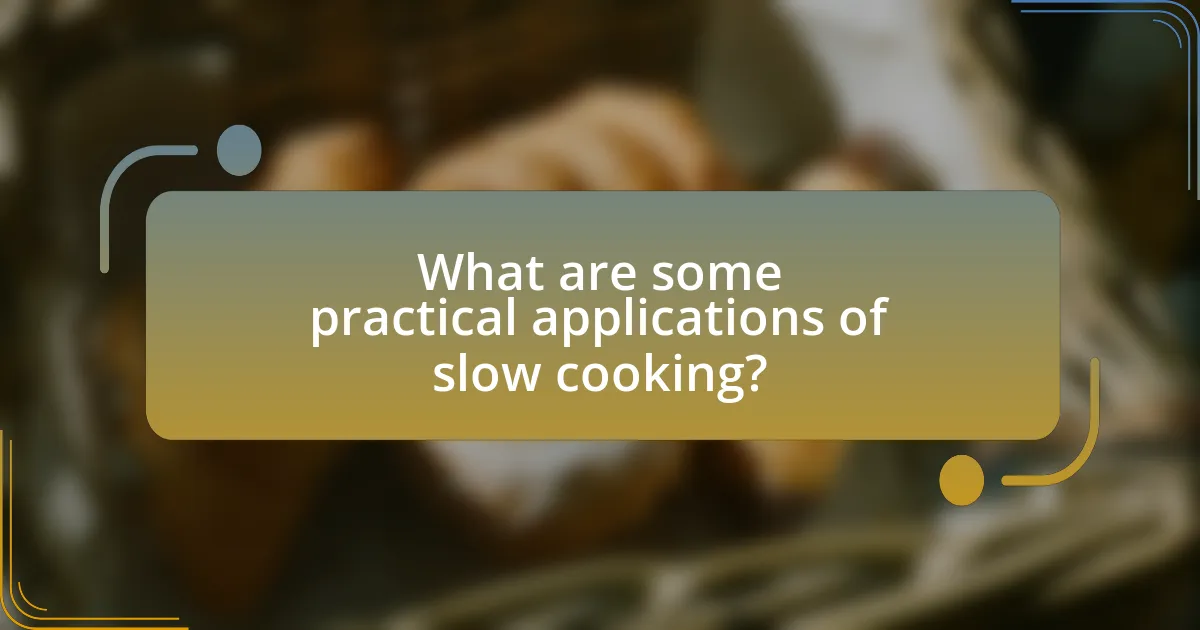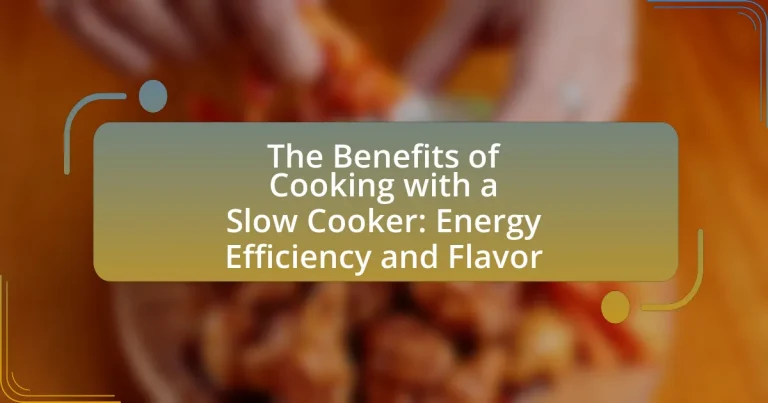The article focuses on the benefits of cooking with a slow cooker, emphasizing energy efficiency and flavor enhancement. It outlines how slow cookers use significantly less electricity compared to conventional cooking methods, making them a sustainable choice for meal preparation. The article details how the slow cooking process allows flavors to meld and develop, resulting in richer dishes, while also tenderizing tougher cuts of meat. Additionally, it discusses practical tips for maximizing the benefits of slow cooking, including ingredient selection, seasoning techniques, and troubleshooting common cooking issues. Overall, the article serves as a comprehensive guide to understanding the advantages and applications of slow cooking in everyday meal preparation.

What are the benefits of cooking with a slow cooker?
Cooking with a slow cooker offers several benefits, including energy efficiency, enhanced flavor, and convenience. Slow cookers use less electricity compared to conventional ovens, making them a more energy-efficient option for meal preparation. Additionally, the low and slow cooking method allows flavors to meld and develop more deeply, resulting in richer and more complex dishes. This method also tenderizes tougher cuts of meat, making them more palatable. Furthermore, slow cookers provide convenience by allowing meals to be prepared in advance and cooked unattended, freeing up time for other activities.
How does a slow cooker enhance flavor in meals?
A slow cooker enhances flavor in meals by allowing ingredients to cook slowly and evenly, which promotes the melding of flavors. The low and consistent heat breaks down tough fibers in meats and vegetables, releasing natural juices and intensifying the overall taste. Additionally, the sealed environment of a slow cooker traps moisture and aromas, preventing evaporation and ensuring that flavors remain concentrated. This method of cooking can lead to richer, more complex flavors compared to quicker cooking methods, as evidenced by culinary studies that show slow-cooked dishes often have a deeper flavor profile due to the extended cooking time.
What cooking techniques contribute to flavor development in a slow cooker?
Browning ingredients before adding them to a slow cooker significantly contributes to flavor development. This technique, known as the Maillard reaction, occurs when proteins and sugars in food are exposed to high heat, creating complex flavors and aromas. Additionally, layering ingredients strategically, such as placing denser vegetables at the bottom and meats on top, allows for better flavor infusion as the cooking process progresses. The slow cooking method also enables the gradual release of flavors from herbs and spices, enhancing the overall taste profile of the dish.
How does slow cooking affect the texture of ingredients?
Slow cooking significantly alters the texture of ingredients by breaking down tough fibers and connective tissues, resulting in a tender and more palatable final dish. This method utilizes low temperatures over extended periods, allowing proteins in meats to denature and collagen to dissolve, which enhances the overall mouthfeel. For example, cuts of meat that are typically tough, such as chuck roast, become fork-tender after several hours in a slow cooker due to this gradual cooking process. Additionally, vegetables soften and release their natural sugars, contributing to a creamy texture and richer flavor profile.
Why is energy efficiency important in cooking?
Energy efficiency is important in cooking because it reduces energy consumption, leading to lower utility bills and a smaller carbon footprint. Cooking methods that utilize energy efficiently, such as slow cooking, can use up to 70% less energy compared to traditional cooking methods. This efficiency not only conserves resources but also promotes sustainable practices in the kitchen, contributing to environmental conservation.
How does a slow cooker compare to other cooking methods in energy consumption?
A slow cooker generally consumes less energy compared to other cooking methods such as ovens and stovetops. Specifically, a slow cooker uses about 70-80 watts of electricity, while an oven can use 2,000-5,000 watts. This significant difference in wattage indicates that slow cookers are more energy-efficient for long cooking times. Additionally, studies show that using a slow cooker can save up to 30-50% in energy costs compared to traditional cooking methods, making it a more economical choice for preparing meals over extended periods.
What are the environmental benefits of using a slow cooker?
Using a slow cooker offers significant environmental benefits primarily through energy efficiency. Slow cookers typically consume less electricity compared to conventional ovens, using about 70% less energy, which reduces overall carbon emissions associated with cooking. Additionally, the prolonged cooking time at lower temperatures allows for the use of less processed ingredients, promoting sustainable food practices. This method also minimizes food waste, as slow cooking can tenderize tougher cuts of meat and utilize leftover vegetables, thereby maximizing resource use.
What types of meals are best suited for slow cooking?
Hearty meals such as stews, soups, and braised meats are best suited for slow cooking. These types of meals benefit from the low, steady heat of a slow cooker, which allows flavors to meld and tough cuts of meat to become tender over time. For example, beef stew made with chuck roast becomes flavorful and tender after several hours of slow cooking, as the collagen in the meat breaks down. Additionally, dishes like chili and pulled pork also thrive in slow cookers, as the extended cooking time enhances the depth of flavor and texture.
Which ingredients work well in a slow cooker?
Meats, vegetables, legumes, and grains work well in a slow cooker. Meats such as beef, pork, and chicken become tender and flavorful when cooked slowly, as the low heat breaks down collagen and connective tissues. Root vegetables like carrots, potatoes, and onions hold their shape and absorb flavors over long cooking times. Legumes, including lentils and beans, soften and cook evenly, while grains like rice and quinoa can be cooked to a perfect texture. The slow cooking process enhances the overall flavor profile of these ingredients, making them ideal for this cooking method.
How can slow cooking be adapted for different cuisines?
Slow cooking can be adapted for different cuisines by incorporating specific spices, ingredients, and cooking techniques unique to each culinary tradition. For instance, in Italian cuisine, slow cooking can involve using tomatoes, garlic, and herbs like basil and oregano to create rich sauces, while in Indian cuisine, spices such as cumin, coriander, and turmeric can be used to develop complex flavors in dishes like curries. Additionally, traditional methods such as braising meats in Asian cuisines can be effectively replicated in a slow cooker, allowing for tender results that enhance the dish’s authenticity. This adaptability is supported by the versatility of slow cookers, which can maintain low, consistent temperatures ideal for breaking down tough cuts of meat and melding flavors over time, a technique common in many global cooking styles.

How can you maximize the benefits of using a slow cooker?
To maximize the benefits of using a slow cooker, focus on selecting the right ingredients and cooking techniques. Using tougher cuts of meat, such as chuck roast or pork shoulder, enhances flavor and tenderness through slow cooking, as these cuts break down collagen over time. Additionally, layering ingredients properly—placing root vegetables at the bottom and meat on top—ensures even cooking and prevents burning.
Furthermore, using the slow cooker for longer cooking times, typically between 6 to 8 hours on low heat, allows flavors to meld and develop more fully. According to a study by the USDA, slow cooking can also retain more nutrients compared to other cooking methods, making meals healthier. Lastly, experimenting with spices and herbs can elevate the taste, as the slow cooking process allows these flavors to infuse deeply into the dish.
What tips can improve flavor when using a slow cooker?
To improve flavor when using a slow cooker, incorporate aromatic ingredients such as onions, garlic, and herbs at the beginning of the cooking process. These ingredients release their essential oils and flavors over time, enhancing the overall taste of the dish. Additionally, browning meats before adding them to the slow cooker can create a Maillard reaction, which adds depth and richness to the flavor profile. Using high-quality broth or stock instead of water also intensifies the flavor, as it provides a more robust base for the dish. Finally, adding acidic ingredients like tomatoes or vinegar towards the end of cooking can brighten and balance the flavors, making the dish more complex and enjoyable.
How can seasoning be effectively used in slow cooking?
Seasoning can be effectively used in slow cooking by adding it at different stages to enhance flavor development. Initially, incorporating salt and spices at the beginning allows them to infuse into the ingredients over time, creating a deeper flavor profile. Additionally, adding fresh herbs or delicate spices towards the end of the cooking process preserves their aromatic qualities, ensuring a vibrant taste. Research indicates that slow cooking allows for the gradual release of flavors, making it essential to balance seasoning throughout the cooking duration for optimal results.
What are some common mistakes to avoid for better flavor?
To achieve better flavor when using a slow cooker, avoid overcooking ingredients, as this can lead to mushy textures and loss of distinct flavors. Overcooking often occurs when cooking times exceed recommended durations, which can diminish the taste of vegetables and proteins. Additionally, neglecting to season properly at different stages can result in bland dishes; seasoning at the beginning and adjusting towards the end enhances flavor complexity. Lastly, overcrowding the slow cooker can prevent even cooking and flavor development, as ingredients need space for proper heat circulation. These practices are essential for maximizing flavor in slow-cooked meals.
How can you ensure energy efficiency while using a slow cooker?
To ensure energy efficiency while using a slow cooker, utilize the appliance during off-peak energy hours and keep the lid closed during cooking. Slow cookers are designed to retain heat, which means that lifting the lid can significantly increase cooking time and energy consumption. According to the U.S. Department of Energy, slow cookers use about 70% less energy than conventional ovens, making them a more efficient option for meal preparation. Additionally, using the slow cooker for longer cooking times allows for energy savings, as it operates at a low wattage, typically between 70 to 250 watts, compared to an oven that can use 2,000 watts or more.
What practices can reduce energy consumption during cooking?
Using a slow cooker can significantly reduce energy consumption during cooking. Slow cookers typically use less electricity than conventional ovens, averaging around 70-80% less energy. Additionally, cooking with a lid on retains heat and moisture, which further enhances energy efficiency. Prepping ingredients in advance and using the slow cooker during off-peak energy hours can also contribute to lower energy usage. According to the U.S. Department of Energy, slow cookers are an energy-efficient option for meal preparation, making them a practical choice for reducing overall energy consumption in the kitchen.
How does meal planning contribute to energy efficiency with a slow cooker?
Meal planning enhances energy efficiency with a slow cooker by allowing users to prepare multiple meals at once, reducing the need for repeated cooking sessions. When meals are planned, ingredients can be combined and cooked together, maximizing the slow cooker’s capacity and minimizing energy consumption. According to the U.S. Department of Energy, slow cookers use about 30% less energy than conventional ovens, making efficient meal planning even more beneficial. By consolidating cooking times and utilizing the slow cooker effectively, households can lower their overall energy usage while enjoying nutritious meals.

What are some practical applications of slow cooking?
Slow cooking is practically applied in meal preparation, allowing for tenderizing tough cuts of meat, enhancing flavors through prolonged cooking, and providing convenience for busy lifestyles. For instance, slow cookers can transform inexpensive cuts of beef into flavorful stews, as the low and slow cooking method breaks down collagen, resulting in a tender texture. Additionally, slow cooking allows for the melding of flavors in dishes like chili or soups, where ingredients can simmer together for hours, creating a rich taste profile. This method also promotes energy efficiency, as slow cookers typically use less electricity than conventional ovens, making them a cost-effective option for home cooking.
How can slow cookers be used for meal prep?
Slow cookers can be used for meal prep by allowing users to prepare large batches of food in advance, which can be portioned and stored for later consumption. This method saves time and energy, as ingredients can be combined and cooked together over several hours, resulting in flavorful meals that are ready to eat or easily reheated. Studies show that using a slow cooker can reduce energy consumption compared to traditional cooking methods, making it an efficient choice for meal preparation. Additionally, the slow cooking process enhances flavors, making meals more enjoyable and satisfying.
What are some easy slow cooker recipes for beginners?
Some easy slow cooker recipes for beginners include chili, chicken and rice, and vegetable soup. Chili can be made by combining ground beef, canned tomatoes, beans, and spices, cooking on low for 6-8 hours. Chicken and rice involves placing chicken breasts, rice, broth, and vegetables in the slow cooker, cooking on low for 4-6 hours. Vegetable soup can be prepared by adding chopped vegetables, broth, and seasonings, cooking on low for 6-8 hours. These recipes are straightforward, require minimal preparation, and are ideal for those new to slow cooking.
How can slow cooking be integrated into a busy lifestyle?
Slow cooking can be integrated into a busy lifestyle by utilizing a slow cooker to prepare meals in advance, allowing for hands-off cooking while managing other tasks. This method enables individuals to combine ingredients in the morning, set the cooker, and return home to a fully cooked meal, thus saving time and reducing stress. Research indicates that slow cooking can enhance flavor and tenderness in dishes, making it a practical choice for busy individuals seeking nutritious meals without extensive preparation time.
What troubleshooting tips can help with slow cooker cooking?
To troubleshoot slow cooker cooking, ensure the lid is properly sealed to maintain heat and moisture, as an improperly fitted lid can lead to longer cooking times. Additionally, check that the slow cooker is set to the correct temperature setting; using the low setting typically requires 6-8 hours, while the high setting requires 3-4 hours for optimal results. If food is not cooking evenly, consider cutting ingredients into uniform sizes to promote even cooking. Lastly, avoid opening the lid frequently, as this can significantly increase cooking time by releasing heat. These tips are supported by the fact that slow cookers rely on consistent heat retention and moisture to effectively cook food over extended periods.
How can you fix common issues like undercooked meals?
To fix undercooked meals, increase the cooking time or adjust the temperature settings of the slow cooker. Slow cookers typically operate at low and high settings, and ensuring that the meal reaches the appropriate internal temperature is crucial for food safety and proper cooking. For example, meats should reach a minimum internal temperature of 145°F for safety. If a meal is undercooked, extending the cooking duration by an additional hour or increasing the temperature setting can help achieve the desired doneness.
What should you do if meals are too watery or dry?
If meals are too watery, you should thicken them by adding ingredients like cornstarch or flour mixed with water, or by simmering the dish uncovered to allow excess liquid to evaporate. Conversely, if meals are too dry, you can add moisture by incorporating broth, water, or cream, or by covering the dish to trap steam and enhance moisture retention. These methods are effective because they directly address the consistency of the meal, ensuring a balanced texture that enhances flavor and enjoyment.


